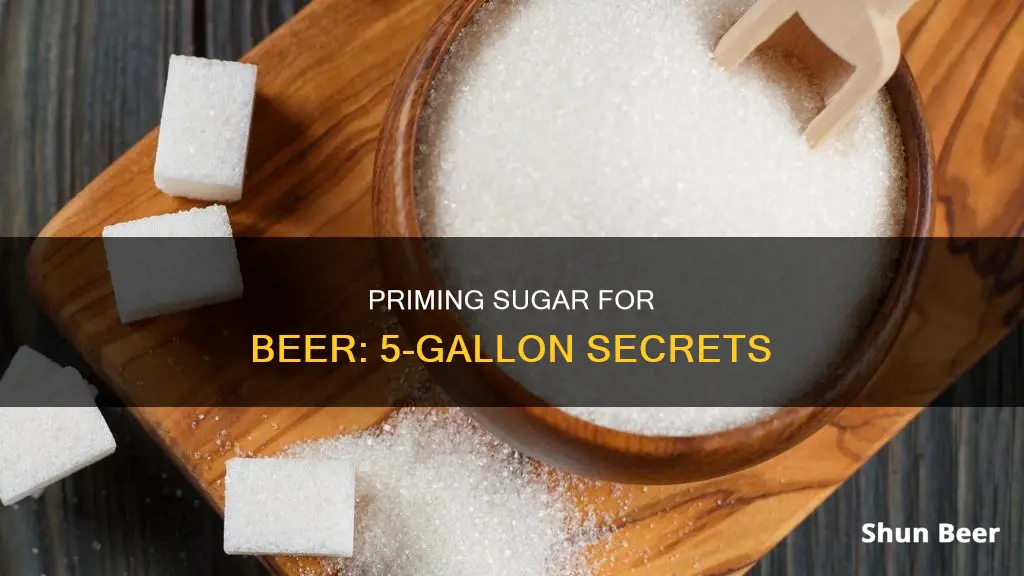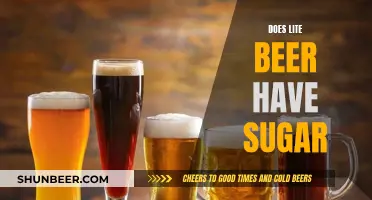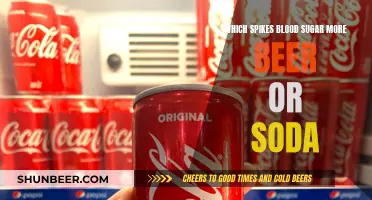
Carbonation is a crucial step in the beer-making process, and priming sugar is key to achieving the desired level of carbonation in your brew. Priming sugar is the main component in the priming solution, which, when added to the beer during bottling, provides food for the yeast to create carbon dioxide (CO2) and, thus, the desired fizz. While you can certainly drink your beer without carbonation, adding priming sugar will give it that refreshing, bubbly texture and bring out the best flavours.
| Characteristics | Values |
|---|---|
| Purpose | Prepare beer for carbonation in bottles |
| When to add | After fermentation is complete, before bottling |
| How much to add | 5 oz. per 5 gallons of beer |
| How to add | Dissolve in water and boil |
| Types of priming sugar | Corn sugar, table sugar, dry malt extract, honey |
What You'll Learn

The role of priming sugar
The amount of priming sugar needed varies depending on the type and volume of the beverage. As a rule of thumb, for 5 gallons of beer, you would need 3/4 cup of corn sugar, 2/3 cup of table sugar, or 1 1/4 cups of DME. However, the amount of priming sugar can be adjusted slightly depending on the style of beer and personal preference.
Priming sugar is important because it gives the yeast a final source of sugar to feed on, allowing them to produce carbon dioxide (CO2) and add bubbles to the brew. This process is called bottle conditioning, and it usually takes about two weeks for the priming sugar to fully carbonate the beer.
Using priming sugar is quite easy. First, you need to prepare your bottles for carbonation and your bottle caps to ensure that the bottles are closed as soon as possible after bottling. Then, you can create a priming sugar solution by boiling water and adding the desired amount of sugar, stirring until it is completely dissolved. This solution is then added to the bottling bucket before transferring the beer from the fermenter to the bucket, mixing the two together. Finally, the beer is bottled and capped, and stored in a cool, dark place.
Different types of priming sugar can have different effects on the beer. While corn sugar and cane sugar generally do not contribute any flavor, DME can influence the taste of the beer since it is made from grains. Natural sugars such as brown sugar or honey can also be used, which will add a nice taste and aroma to the beer. However, it is important to note that using too much priming sugar can result in over-carbonation and cause bottles to explode, while using too little can lead to under-carbonated beer.
Sugar in Beer: What's the Sweet Percentage?
You may want to see also

How much priming sugar is needed for 5 gallons
The amount of priming sugar needed for 5 gallons of beer depends on the type of sugar used. The most popular priming sugars are corn sugar (dextrose), table sugar (sucrose), and dry malt extract (DME).
Corn Sugar (Dextrose)
The standard amount of corn sugar (dextrose) recommended for priming 5 gallons of beer is 3/4 cups (6 ounces or 113 grams). This measurement accounts for the sugar's volume and fermentability and will produce a nice level of carbonation for most beers.
Table Sugar (Sucrose)
For table sugar (sucrose), the standard amount is slightly less at 2/3 cup (5.3 ounces or 150 grams) for 5 gallons of beer. This is because table sugar has no water content, so it is more concentrated than corn sugar.
Dry Malt Extract (DME)
Dry malt extract (DME) is a bit different, as it requires additional calculation to determine the correct amount. The standard amount of DME for priming 5 gallons of beer is 1 1/4 cups (181 grams). However, to ensure optimal carbonation, you need to know the true fermentability of the DME, which is calculated by multiplying the apparent fermentability (usually listed on the package) by 0.82.
Honey
Honey is a less conventional priming agent and can be more challenging to work with due to its variable density, composition, and viscosity. The general rule of thumb for honey is to use between 1/2 cup and 1 cup for 5 gallons of beer, depending on the desired carbonation level.
Priming Sugar Calculators
It is important to note that these are standard measurements, and the exact amount of priming sugar needed may vary depending on the specific beer style and target carbonation level. For a more precise calculation, you can use online priming sugar calculators, which take into account factors such as the residual carbonation, target carbonation, temperature, and type of sugar used.
Coke vs Beer: Which Drink Contains More Sugar?
You may want to see also

The best types of priming sugar
When it comes to priming sugar for your beer, you can use any type of fermentable sugar. However, some sugars are more popular than others and will benefit your beer more.
The three most popular types of priming sugar are corn sugar (dextrose), table sugar (sucrose), and dry malt extract (DME). Corn sugar is the most popular bottling sugar as it is cheap and leaves no added flavour. It is also the most popular priming sugar. Table sugar is also flavourless and is the standard white sugar you'd find in your cupboard. Dry malt extract is the third most popular option and is used in place of traditional bulk kräusen priming.
Other sugars you can use include:
- Honey: This can be difficult to prime with as there is no standard for concentration, and the gravity of honey differs from jar to jar. It will also take some extra work as you will need to dilute it and measure its gravity with a hydrometer. However, it can add a nice taste and aroma to your beer.
- Maple syrup: This can dilute the beer quite a bit, but the darker the syrup, the better the flavour.
- Belgian candi syrup: This is coloured and will add more flavour the darker it is.
- Belgian soft candi sugar: Similar to the syrup, the blonde version will add very little colour or flavour, but the brown version will add a lot of flavour.
- Black treacle: A type of molasses that is very dark and will leave a lot of flavour.
- Brown sugar: The flavour increases the darker the sugar is.
- Demerara: The lightest unrefined sugar with very little flavour.
- Sorghum syrup: Used mainly for non-gluten beers.
- Turbinado: A light brown sugar that is also known as 'sugar in the raw'.
- Invert sugar syrup: An English version of Belgian candi syrup.
- Molasses: Similar to black treacle.
- Rice solids: Sugar derived from rice.
- Dark and light corn syrup: No flavour.
When choosing a priming sugar, it is important to take into account the temperature of the beer, the volume, the level of carbonation desired, and the type of sugar.
Priming Beer: Corn Sugar's Role and Benefits
You may want to see also

How to mix priming sugar
To mix priming sugar for a 5-gallon batch of beer, you will need 5 oz (2/3 cup) of priming sugar and 2 cups of water. Combine the priming sugar with water in a large pot and stir over medium-high heat until the sugar is dissolved. Bring the mixture to a boil for 5 minutes, then remove it from the heat, cover it, and let it cool completely. While you wait, you can prepare your bottling bucket and sanitise your bottles and caps.
Once the priming solution is cooled, transfer your beer from the fermenter into the pot with the priming solution and gently stir to combine. Now your beer is ready to bottle! Using a bottle filler, carefully transfer your brew to your bottles, filling them to the top. Capping your beers with a handheld capper, set them aside in a dry, room-temperature place so that the yeast will remain active and generate carbonation as they consume the priming sugar solution.
Wait at least two weeks for fermentation to complete. After this time, chill one beer, then crack it open to test it. If it’s not quite ready, age the remaining bottles for a few more days. If the first beer looks, smells, and tastes great, then it’s time to enjoy the fruits of your labour!
The Truth About IPA Beer and Sugar Content
You may want to see also

How to bottle beer
Bottling beer is the final step in the brewing process. This is when you'll add priming sugar to your beer to carbonate it and make it bubbly and refreshing. The priming sugar gives the yeast food to create carbon dioxide (CO2) over a two-week period as the beer ages in the bottle.
Step 1: Prepare the Priming Solution
First, you'll need to prepare a priming solution by combining priming sugar and water. For a 5-gallon batch of beer, you'll need 5 ounces (about 3/4 cup) of priming sugar and 2 cups of water. Combine these in a large pot and stir over medium-high heat until the sugar is dissolved. Then, boil the mixture for 5 minutes, remove it from the heat, cover it, and let it cool completely.
Step 2: Combine Beer and Priming Solution
Once your priming solution is completely cooled, it's time to combine it with your beer. Gently stir the priming solution into your beer in a bottling bucket. Be careful not to pull any of the trub (the sediment at the bottom of your brew) into the bucket, as it can alter the flavor and clarity of your beer.
Step 3: Bottle the Beer
Using a bottle filler, carefully transfer your brew into bottles, filling them all the way to the top. Removing the bottle filler wand will leave about 3/4 to 1 inch of headspace to allow for proper carbonation.
Step 4: Cap and Store the Bottles
Cap your bottles with a handheld capper and set them aside in a dry, room-temperature place. The yeast will remain active and generate carbonation in your beer as they consume the priming sugar solution.
Step 5: Wait and Enjoy
This is the hardest part: wait two weeks for fermentation to complete. After that, chill a bottle and crack it open to test. If it's not quite ready, let the remaining bottles age for a few more days. If it's perfect, then it's time to enjoy the fruits of your labor!
India Pale Ale: Sugar Content and Its Influence
You may want to see also
Frequently asked questions
The rule of thumb for a 5-gallon batch is 3/4 cup of corn sugar, 2/3 cup of table sugar, or 1 1/4 cups of DME.
Combine the priming sugar with water in a large pot. For a 5-gallon batch, use 5 oz (2/3 cup) of priming sugar with 2 cups of water. Bring to a medium-high heat, stir to dissolve the sugar, then boil for 5 minutes. Remove from the heat, cover, and let it cool. Once cooled, transfer your beer from the fermenter into the pot with the priming solution and gently stir to combine.
Priming sugar is added to beer before bottling to prepare it for carbonation. The yeast converts this sugar into CO2 inside sealed bottles, creating a fizzy, carbonated brew.
Corn sugar, table sugar, and dry malt extract (DME) are the most popular forms of priming sugar. Corn sugar is the classic sugar used for priming and is known for providing consistent carbonation without greatly affecting flavour.







